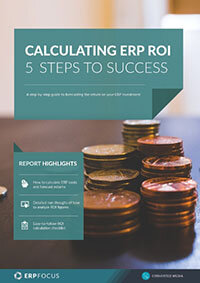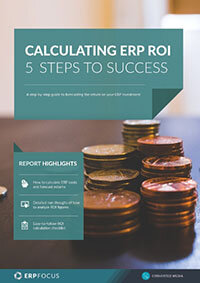ERP return on investment - a chimera or just a mirage?
Early commercial computer systems were designed to replace people doing manual transactions. A typical example would be a system called LEO from the early 1950s, with LEO standing for Lyons Electronic Office. Lyons was a chain of tea shops in the UK and those tea shops generated an enormous number of transactions that had to be processed, which meant an enormous number of accounts clerks.
Replacing those clerks was not only likely to save costs but the resultant savings were both very measurable and very easy to measure. When computers began to be introduced into other departments, though, there had to be justifications other than staff reductions because most of those other departments were, and are, noticeably less transaction heavy than accounts.
So efficiency improvements were targeted and things like inventory reduction, production lead time reduction, increased sales and lower purchasing costs were identified as things that could be calculated and measured. That made sense because all of these are things that a well-implemented ERP system will improve.
Typically an ROI calculation for an ERP system will quote things like a percentage decrease in inventory (raw materials, work in progress, and finished goods), a percentage decrease in purchasing costs, and a percentage increase in sales. All of these are achievable but the problem is that the percentages used in the calculation are targets and not guarantees and, in fact, frequently companies start will some figures and increase them iteratively until they get the desired result.
Some start with the result (a number that equates to the anticipated project cost) and work backward to calculate the percentage improvements necessary to match that cost. When asked to justify the numbers in an ROI, the most usual answers are that they 'seemed reasonable' or that they were quoted in vendors' marketing material as improvements that other companies had achieved.
To obtain meaningful numbers, some organizations pay for bench-mark studies that compare relevant metrics against other companies in their industry, but this needs to be done by experts and the results need very careful consideration and interpretation. A measurement might show, for example, that their stock turns are lower than average but does that mean that stocks are too high, or does it mean that sales are too low?
If sales are low because prices are high or advertising is ineffective, then reducing stock holdings might lead to reduced service levels and even lower sales. There are many interdependencies in ERP and sometimes mere numbers don't tell the full story. ROI is very hard to measure but, regardless of the calculation, one thing is certain and that is that actual performance is rarely checked afterward to validate the claims.
To an extent, this is understandable because finding out that the numbers lack validity after the system has been bought and implemented seems like closing the stable door after the horse has bolted. Another reason is that implementing an ERP system takes time (a Tier 1 system is typically going to take at least two years for a relatively straightforward implementation through to seven or more years for a complex multi-site project).
During that time, things will change. Trading conditions may change, other company initiatives will come into effect and very likely new and replacement employees will join. So, although the metrics may well indicate that things have improved, just how much of that improvement is due to the new ERP system will be impossible to calculate.
As an aside: this does not mean that the metrics were badly chosen, or that they should not be continually checked. It strengthens the argument for having them because, if things are not improving since the launch of the new system, it is time to start considering doing something more or something different.
If bench-marking is problematic and ROI calculations almost meaningless, what can a company do to justify the expense of a new system? One option is to bring in expert ERP consultants to carry out a review of the company's needs and to identify areas where improvements are realizable.
The problem here is that these consultants will likely be the same people who will be needed during ERP selection and implementation, so it is highly unlikely that they are going to come up with any answer other than that the company does indeed need a new system.
The second option is for the company to reflect on why it thinks it needs a new system. Sometimes the reason is that its existing system, or systems, are creaking under increasing strain, and relying on them not to fail is becoming an unacceptable business risk.
At this point, an ROI calculation becomes irrelevant and all that a company has to decide is how much it will cost to implement a replacement and what capabilities will be required in it. More difficult is when an organization does not have such a pressing need and the desire for a new system is driven purely by a desire to improve overall company performance.
Then the company needs to decide whether the existing system is capable of supporting that journey. Frequently that is not the sort of decision that ROI can help with, so senior management needs to make a judgment call. In doing so, they can use external consultants as sounding boards (notwithstanding the previous comment about consultants sometimes having their objectives) and can also talk to the management teams of both suppliers and customers who have trodden the path recently.
Implementing an ERP system is a time-consuming and expensive endeavor and, even though an ROI exercise may not be the best way to start, advice is available from a range of sources. And, of course, there are many articles available on the website to help!
Free white paper

Calculating ERP ROI: 5 steps to success
Calculate your new ERP's financial benefits with this comprehensive guide

Featured white papers
Related articles
-
![Three direct links between ERP and manufacturing revenue [image by Snowing on Freepik] Three direct links between ERP and manufacturing revenue [image by Snowing on Freepik]](/pictures/W1siZiIsIjIwMjUvMDEvMjAva2ZwYjAzb3gzX1RocmVlX2RpcmVjdF9saW5rc19iZXR3ZWVuX0VSUF9hbmRfbWFudWZhY3R1cmluZ19yZXZlbnVlX2ltYWdlX2J5X1Nub3dpbmdfb25fRnJlZXBpa18uanBnIl0sWyJwIiwidGh1bWIiLCI0MDB4MjY2IyJdLFsicCIsImVuY29kZSIsImpwZyIsIi1xdWFsaXR5IDg1Il1d/Three%20direct%20links%20between%20ERP%20and%20manufacturing%20revenue%20%5Bimage%20by%20Snowing%20on%20Freepik%5D.jpg?sha=b45b02a140cc8680)
Three direct links between ERP and manufacturing revenue
What you need to know to help you achieve a return on your manufacturing ERP investment
-

CMMC Compliance: What Aerospace and Defense Manufacturers Need to Know
Key insights on CMMC compliance, deadlines, and securing DoD contracts with CMMC 2.0 certificatio...
-
![3 Tips for Achieving Buy-In for Your ERP Integration [by pressfoto on Freepik] 3 Tips for Achieving Buy-In for Your ERP Integration [by pressfoto on Freepik]](/pictures/W1siZiIsIjIwMjQvMTAvMjkvNnQyNmRwdzdwYl8zX1RpcHNfZm9yX0FjaGlldmluZ19CdXlfSW5fZm9yX1lvdXJfRVJQX0ludGVncmF0aW9uX2J5X3ByZXNzZm90b19vbl9GcmVlcGlrXy5qcGciXSxbInAiLCJ0aHVtYiIsIjQwMHgyNjYjIl0sWyJwIiwiZW5jb2RlIiwianBnIiwiLXF1YWxpdHkgODUiXV0/3%20Tips%20for%20Achieving%20Buy-In%20for%20Your%20ERP%20Integration%20%5Bby%20pressfoto%20on%20Freepik%5D.jpg?sha=0e1a55a6cfcac344)
3 tips for achieving buy-in for your ERP integration
Read our expert’s tips on getting your ERP integration project off the ground by achieving busine...


